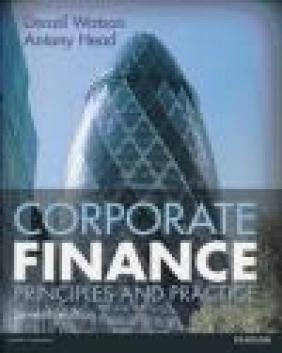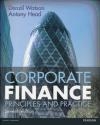Corporate Finance
Antony Head, Denzil Watson
Corporate Finance
Antony Head, Denzil Watson
- Wydawnictwo: Pearson
- Rok wydania: 2016
- ISBN: 9781292103037
- Ilość stron: 520
- Oprawa: Miękka
Niedostępna
Opis: Corporate Finance - Antony Head, Denzil Watson
"Strikes the right balance between the theoretical concepts and their applications" Ortenca Kume, University of Kent "Written in a refreshing, crisp and precise manner" Jan Schnitzler, VU University Amsterdam In this new and fully updated Seventh Edition of Corporate Finance: Principles and Practice, the key principles and mathematical techniques are clearly explained step-by-step and put into practice through numerous vignettes which take a closer look at real-world and well-known companies. What's new? * Chapter vignettes refreshed to reflect the current economic and financial climate, * along with accompanying questions aiming to deepen student's knowledge of key * contemporary issues * All data and tables updated to reflect current trends in key economic variables and * developments in corporate finance * Chapter 1 revised to reflect recent developments in corporate governance * Chapter 11 updated to take account of the changes in UK anti-trust regulation Denzil Watson and Antony Head are Principal Lecturers in Sheffield Business School at Sheffield Hallam University. They have extensive experience of teaching corporate finance, managerial finance and strategic financial management in a wide range of courses at undergraduate, postgraduate and professional level.Preface Acknowledgements 1 The finance function Learning objectives Introduction 1.1 Two key concepts in corporate finance 1.2 The role of the financial manager 1.3 Corporate objectives 1.4 How is shareholder wealth maximised? 1.5 Agency theory 1.6 Corporate governance 1.7 Conclusion Key points Self-test questions Questions for review Questions for discussion References Recommended reading 2 Capital markets, market efficiency and ratio analysis Learning objectives Introduction 2.1 Sources of business finance 2.2 Capital markets 2.3 Capital market efficiency 2.4 Assessing financial performance 2.5 Conclusion Key points Self-test questions Questions for review Questions for discussion References Recommended reading 3 Short-term finance and the management of working capital Learning objectives Introduction 3.1 The objectives of working capital management 3.2 Working capital policies 3.3 Working capital and the cash conversion cycle 3.4 Overtrading 3.5 Managing inventory 3.6 Managing cash 3.7 Managing receivables 3.8 Conclusion Key points Self-test questions Questions for review Questions for discussion References Recommended reading 4 Long-term finance: equity finance Learning objectives Introduction 4.1 Equity finance 4.2 The stock exchange 4.3 Rights issues 4.4 Scrip issues, share splits, scrip dividends and share repurchases 4.5 Preference shares 4.6 Conclusion Key points Self-test questions Questions for review Questions for discussion References Recommended reading 5 Long-term finance: debt finance, hybrid finance and leasing Learning objectives Introduction 5.1 Bonds, loan notes, loan stock and debentures 5.2 Bank and institutional debt 5.3 International debt finance 5.4 Convertible bonds 5.5 Warrants 5.6 The valuation of fixed-interest bonds 5.7 The valuation of convertible bonds 5.8 Leasing 5.9 Evaluating the financial effect of financing choices 5.10 Conclusion Key points Self-test questions Questions for review Questions for discussion References Recommended reading 6 An overview of investment appraisal methods Learning objectives Introduction 6.1 The payback method 6.2 The return on capital employed method 6.3 The net present value method 6.4 The internal rate of return method 6.5 A comparison of the npv and irr methods 6.6 The profitability index and capital rationing 6.7 The discounted payback method 6.8 Conclusion Key points Self-test questions Questions for review Questions for discussion References Recommended reading 7 Investment appraisal: applications and risk Learning objectives Introduction 7.1 Relevant project cash flows 7.2 Taxation and capital investment decisions 7.3 Inflation and capital investment decisions 7.4 Investment appraisal and risk 7.5 Appraisal of foreign direct investment 7.6 Empirical investigations of investment appraisal 7.7 Conclusion Key points Self-test questions Questions for review Questions for discussion References Recommended reading 8 Portfolio theory and the capital asset pricing model Learning objectives Introduction 8.1 The measurement of risk 8.2 The concept of diversification 8.3 Investor attitudes to risk 8.4 Markowitz's portfolio theory 8.5 Introduction to the capital asset pricing model 8.6 Using the capm to value shares 8.7 Empirical tests of the capm 8.8 Conclusion Key points Self-test questions Questions for review Questions for discussion References Recommended reading 9 The cost of capital and capital structure Learning objectives Introduction 9.1 Calculating the cost of individual sources of finance 9.2 Calculating weighted average cost of capital 9.3 Average and marginal cost of capital 9.4 The capm and investment appraisal 9.5 Practical problems with calculating wacc 9.6 Wacc in the real world 9.7 The cost of capital for foreign direct investment 9.8 Gearing: its measurement and significance 9.9 The concept of an optimal capital structure 9.10 The traditional approach to capital structure 9.11 Miller and modigliani (i): the net income approach 9.12 Miller and modigliani (ii): corporate tax 9.13 Market imperfections 9.14 Miller and personal taxation 9.15 Pecking order theory 9.16 Conclusion: does an optimal capital structure exist? Key points Self-test questions Questions for review Questions for discussion References Recommended reading 10 Dividend policy Learning objectives Introduction 10.1 Dividends: operational and practical issues 10.2 The effect of dividends on shareholder wealth 10.3 Dividend irrelevance 10.4 Dividend relevance 10.5 Dividend relevance or irrelevance? 10.6 Dividend policies 10.7 Alternatives to cash dividends 10.8 Empirical evidence on dividend policy 10.9 Conclusion Key points Self-test questions Questions for review Questions for discussion References Recommended reading 11 Mergers and takeovers Learning objectives Introduction 11.1 The terminology of mergers and takeovers 11.2 Justifications for acquisitions 11.3 Trends in takeover activity 11.4 Target company valuation 11.5 The financing of acquisitions 11.6 Strategic and tactical issues 11.7 Divestment 11.8 Private equity 11.9 Empirical research on acquisitions 11.10 Conclusion Key points Self-test questions Questions for review Questions for discussion References Recommended reading 12 Risk management Learning objectives Introduction 12.1 Interest and exchange rate risk 12.2 Internal risk management 12.3 External risk management 12.4 Futures contracts 12.5 Options 12.6 Swaps 12.7 Issues in interest and exchange risk management 12.8 Political risk 12.9 Conclusion Key points Self-test questions Questions for review Questions for discussion References Recommended reading Answers to self-test questions Glossary Present value tables Index
Producent:
GPSR Pearson Central Europe Sp. z o.o.
ul. Szamocka 8
01-748 Warszawa (PL)
tel: 459 596 060
email: [email protected]
Szczegóły: Corporate Finance - Antony Head, Denzil Watson
Tytuł: Corporate Finance
Autor: Antony Head, Denzil Watson
Wydawnictwo: Pearson
ISBN: 9781292103037
Rok wydania: 2016
Ilość stron: 520
Oprawa: Miękka
Waga: 1 kg






























